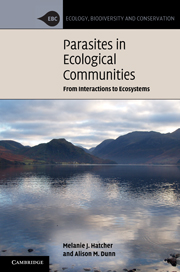Book contents
- Frontmatter
- Contents
- Acknowledgements
- List of abbreviations
- 1 Introduction
- 2 Parasites and competitors
- 3 Parasites and predators
- 4 Parasites and intraguild predation
- 5 Plant pathogens and parasitic plants
- 6 Parasites and invasions
- 7 Ecosystem parasitology
- 8 Emerging diseases in humans and wildlife
- 9 Where do we go from here?
- References
- Index
7 - Ecosystem parasitology
Published online by Cambridge University Press: 05 August 2012
- Frontmatter
- Contents
- Acknowledgements
- List of abbreviations
- 1 Introduction
- 2 Parasites and competitors
- 3 Parasites and predators
- 4 Parasites and intraguild predation
- 5 Plant pathogens and parasitic plants
- 6 Parasites and invasions
- 7 Ecosystem parasitology
- 8 Emerging diseases in humans and wildlife
- 9 Where do we go from here?
- References
- Index
Summary
Introduction
The previous chapters give an indication of the numerous potential effects of parasites on ecological communities, and effects of communities on parasites. We have met some of the salient interactions in previous chapters:
Parasites can act as keystone species determining coexistence outcomes for competing species, or as agents of apparent competition (Chapter 2).
Parasites can alter predator–prey interactions, engaging in resource competition with predators (as parasites of prey), altering predator–prey dynamics (as parasites of predators, prey or both) and altering interaction strengths via behavioural manipulation (by trophically transmitted parasites) (Chapter 3).
Parasites can alter or engage in intraguild predation (IGP), altering population dynamic and coexistence outcomes (Chapter 4).
Parasites of plants can have cascading effects on consumers via their impact on the host plant; a wealth of indirect interactions between pathogens, parasites, herbivores and their natural enemies may result from plant defensive signalling (Chapter 5).
Up to this point we have looked at interactions at the level of the module, concentrating on strongly interacting subsets of species. But what are the consequences of such effects for the broader community? Do parasite-mediated interactions ramify across communities to influence food webs, community stability and structure? Perhaps these module-level interactions are ‘averaged out’ or ‘diluted’ with the addition of further species and are inconsequential for community-level processes.
- Type
- Chapter
- Information
- Parasites in Ecological CommunitiesFrom Interactions to Ecosystems, pp. 265 - 319Publisher: Cambridge University PressPrint publication year: 2011



